On the "pocket" battleships, Tsushima syndrome and the gloomy Teutonic strategic genius
Suddenly, a message from Captain Bell: “I think this is a“ pocket ”battleship.”
Thus began the first major naval battle of the second world war, which became one of the few classic artillery battles between large warships. Representatives of opposing concepts were confronted in it: the German “trade disruptor” - the pocket battleship “Admiral Graf Spee”, and the British “trade advocate” “Exeter”, supported by two light cruisers. What happened?
The British commander, Commodore Henry Harwood, divided his ships into two groups, with the Exeter turned to the left and rushed at the enemy, and the light cruisers tried to put the enemy in two fires. The commander of the "Spee", Hans Wilhelm Langsdorf also showed a healthy aggressiveness and went to a rapprochement with the enemy.
The battle began in 06.18 - the German raider was the first to fire from the 100 cable distance. In 06.20, in response, heavy 203-mm Exeter cannons struck, after a minute, Akilez supported him, and approximately at 06.23, Ajacks guns entered the scene.
In the first minutes of the battle, the German commander acted exemplary. He commissioned both towers of the main caliber and concentrated their fire on his main enemy, the heavy cruiser of the British. At the same time, the auxiliary 150-mm (actually 149,1 mm, but for brevity we will write the standard 150-mm) tools of the “pocket” battleship fired at the British light cruisers. Since the fire control of the German six-inch was carried out according to the residual principle, they did not achieve any success in the whole battle without achieving a single hit, but the benefit of them was that they irritated the British - being under fire is very difficult psychologically and affects the accuracy of shooting the ship.
Here I would like to note that the British see this moment of battle differently: that at the beginning of the battle, “Spee” divided the fire of its 283-mm guns and each tower fired at its target. But the Germans didn’t confirm anything - both towers fired on the Exeter, just first one tower gave a full three-gun salvo, and after it the second, and only after the target was covered the battleship switched to six-guns. From the outside it could really be perceived as firing at two different targets, especially since the 150-mm German gun fire focused on the British light cruisers (most likely one of them) and the British saw from the shells of the Germans shelling two targets, and not one.
The correct tactics brought the Germans quite predictable success. The first salvos of the 283-mm guns were made semi-armored projectiles, but then the artillery officer “Spee” Usher fired on the high-explosive 300 kg “suitcases” containing 23,3 kg of explosives. This turned out to be a perfectly correct decision, although it was criticized by the Germans after the war. Now the German shells exploded when hitting the water, fragments from close gaps caused Exeter almost more damage than direct hits. The confrontation of six 283-mm raider guns, guided by the traditionally magnificent German SLA and six 203-mm English “budgetary” heavy cruiser, provided with range finders and fire control devices on the principle of minimum sufficiency, led to a quite predictable result.
Already the third volley of the Germans gave cover, with the 283-mm projectile shell splintered the board and Exeter superstructure, and its seaplane, destroying the torpedo apparatus. This was in itself unpleasant, but the fragments also killed the signal readiness circuits. Now the senior artilleryman, Lieutenant Jennings did not know if his guns were ready for a volley, which significantly complicated his shooting. He could still give commands to fire a volley, but now he had no idea how many guns would participate in it, which made it difficult to shoot.
And the Germans continued to methodically shoot the Exeter: their fifth and seventh volleys gave direct hits. The first of them made a semi-slaughter shell with a slowdown - although by that time the Spee had fired high-explosive shells, apparently, the remnants of the semi-slaughter shells fed into the reloading compartment were being shot. This Exeter strike survived relatively safely - a shell pierced the cruiser on both sides and flew off without exploding. But the second hit was fatal. A high-explosive projectile struck the cruiser's nasal 203-mm turret and brought it out completely and failed, igniting a charge in one of the guns of the damaged turret. The cruiser immediately lost a third of its firepower, but the problem was different - the fragments fanned through the Exeter superstructure, killing all the officers, except the captain, but most importantly destroying fire control. Cables and intercoms connecting the rangefinder station with the conning tower and the cabin - with the central post were destroyed. From now on, Exeter, of course, still could shoot, but to get - no longer. Before the failure of the OMS, the heavy cruiser achieved two hits in the enemy’s “pocket” battleship. Exeter fired semi-armored projectiles, so the first hit, which came in an unarmored superstructure, led only to a small through-hole - the projectile flew off without breaking. The second projectile achieved more - breaking through the top of the 100 mm armor belt (although ... among foreign sources there is no consensus about the thickness of the armored belt "Admiral Count Spee". Many people believe that it was only 80 mm, however in our context it does not have practical value) and 40 mm bulkhead. Then he exploded, hitting the armored deck, could not pierce it, but caused a fire in the storage of a dry chemical to extinguish the fire. The people who extinguished the fire were poisoned, but in any case, the combat capability of the German ship did not seriously hurt.
More Exeter has not achieved anything. No, he, of course, continued to fight; it would not be in the tradition of the British to leave the battlefield. But how did he do it? The control of the ship had to be transferred to the aft superstructure, but even there all communication cables were put out of operation, so that the crew had to be transferred to the engine room through a chain of sailors. The two surviving 203-mm towers fired in the direction of the enemy - precisely to the side, because without centralized fire control it would be possible to get into the German raider by luck.
In other words, the British heavy cruiser almost completely lost its combat capability in less than 10 minutes of fire contact with the “pocket” battleship, while he himself failed to inflict any serious damage to the enemy. From the hunter, the Exeter turned into a victim — the cruiser could not oppose the volley of 283-mm guns to his “opponent”.
Why, then, did the cruiser survive? There was not a single reason that prevented "Scheer" from continuing to draw closer and finish off the "Exeter" - and then take up light cruisers. The “pocket” battleship did not have any serious damage - in addition to two 203-mm hits, the British managed to “reach” him with several 152-mm projectiles that did not cause the Nazi raider any serious damage. The fact is that the English light cruisers (as well as the Exeter, by the way) used semi-armored projectiles in the battle, too weak to penetrate the German armor, but flying away without breaking when they hit the unarmored superstructures. And if Langsdorf adhered to his original tactics ...
... but, alas, he did not stick to it.
Disputes still do not cease, who finally won the battle of Jutland - the British or Germans. The thing is that the British, no doubt, suffered much more serious losses, but the battlefield remained behind them, and the badly beaten Hochzeflotte could barely carry his legs. But regardless of the results of these disputes, one cannot but admit that “der Tag” (“Day” is a favorite toast of Kaiserlichmarin officers, glasses were raised during the day when two great fleet converge in a decisive battle) inflicted an indelible mental trauma on the officers of the German fleet. They were ready to fight, they were ready to die, but here they were categorically not ready to conquer the British. It is enough to recall the stupor that Admiral Lutiens fell into when the Hood and the Prince of Wells opened fire on Bismarck. Perhaps the stories about the occurrence of the “Tsushima syndrome” among Russian officers are justified, but it must be admitted that the German commanders were struck by the “Jutland syndrome” in its most severe form.
Captain tzur see Langsdorf did everything he could to overcome it. He bravely led his ship into battle (to be fair, at the time of the decision, Langsdorf believed that he was confronted by a cruiser and two destroyers of the British), and he, like Heyhatiro Togo, Vitgeftu and Beatty, ignored the conning tower on the open bridge.
And so it turned out that at the beginning of the battle the British could not “get” the German raider, they could not even scratch it. But on the other hand, they were able to “get” his commander - the fragments of a six-inch projectile struck Langsdorf in the shoulder and arm, and the energy of the explosion threw him back with such force that he lost consciousness. And when Langsdorf came to his senses, he no longer resembled the admiral of “gray times”. The officers present on the bridge then spoke neatly (honor of the uniform!) That their commander, after being wounded (characterized as insignificant), made “not enough aggressive decisions”
What should Langsdorf do? Continue to go the same course and speed, allowing his gunner, groped "Exeter", to complete the work so successfully begun by him and destroy the largest ship of the British - for this it would be enough to achieve just a few more hits. Here is a diagram with marks of the approximate location of the ships at the time of the battle.
In fact, there is no way to make any exact maneuvering scheme, because the German and English descriptions of the battle differ greatly from each other and have internal contradictions. Therefore, the graphic image is rather arbitrary. But, alas, there is no ambiguity in the actions of the German commander, regardless of when exactly he did this or that action, all sources agree that he transferred the fire of the main caliber to the light cruisers and turned it aside (perhaps in another sequence), thereby ceasing to approach the British ships. Then he seemed to be turning again on the enemy, but he immediately put the smoke curtain on (!) And again showed the British aft, and only then transferred the fire to the Exeter again. Here, the Spee gunners again showed themselves, hitting the British heavy cruiser three times, which caused the latter to lose the second nose tower of the main caliber, and somehow restored the fire control system was destroyed, now - forever. Lieutenant Jennings, however, and here he found a way out of the situation - he simply climbed onto the last surviving tower and led the fire directly from its roof. But in essence, Exeter was on the verge of death - a trim meter on the nose, broken devices, a speed of no more than 17 nodes ... The fruit is ripe, but Langsdorf did not stretch his arms to rip it off.
At this time, the "Spee" actually ran from two enemy light cruisers, occasionally putting up smoke curtains and "chasing after volleys", i.e. turning in the direction where the enemy’s shells fell so that the next enemy volley, adjusted for the previous error, would lead to a miss. Such tactics could be justified if the British commanders of light cruisers used it, if they were pursued by the Spee, but not vice versa. No rational explanation for such a "tactic" can be given. The Germans claimed that their commander, himself a former destroyer, feared the British torpedoes. But precisely because Langsdorf once commanded the destroyers, he simply had to know that weapon practically useless at a distance of 6-7 miles, on which he set off from the British cruisers. Yes, the Japanese with their “long lansy” would be dangerous, but who then knew about it? And it was not the Japanese who fought against Langsdorf. On the contrary, if he was afraid of torpedoes, then he should have approached the British for some time, provoking them to a volley, and then, indeed, retreat - the chances of hitting the “pocket” battleship torpedo after that would be less than illusory.
Another way of explaining Langsdorf’s actions is that he was afraid to take damage that would prevent him from crossing the Atlantic, and for this reason he had to be approached with all seriousness — that it would be a good idea to drown the enemy underaged cruiser if you had to sacrifice a much more powerful ship on empty place? But the fact is that Langsdorf ALREADY got involved in the battle, which the British waged in their characteristic aggressive manner, despite the fact that their cruisers were faster than the “pocket battleship” and the Germans could not interrupt the battle at will. Langsdorf did not win anything, delaying the battle, he needed to complete it as soon as possible, and since he could not escape, then he could only neutralize the British ships as soon as possible. His “pocket” battleship possessed the necessary firepower for this.
In fact, even retreating, the “Admiral Count Spee” could well destroy the English pursuing him. But Langsdorf constantly demanded to transfer fire from one target to another, not letting his gunners properly, or in every way interfered with his “hunt for volleys” by throwing the “pocket” battleship from side to side. It is known that fortune favors the bold, but Langsdorf in this battle did not show courage - perhaps therefore a sad misunderstanding added to the mistakes he made. During the battle, there was no such case when the German fire control system would be incapacitated, but at the crucial moment when the distance between Spee and Harwood light cruisers was less than 6 miles and Langsdorf once again ordered to move the fire from Ajacks "At Akilos, the connection between the wheelhouse and the rangefinder was broken. As a result, the gunners fired at Akilez, but the range-finders continued to tell them the distance to Ajacks, so, naturally, the Spee did not hit anyone.
However, a detailed description of the battle of La Plata is not the task of this article. All of the above said to the fact that a dear reader noted for themselves quite simple facts.
When creating “pocket” battleships, it was necessary to find a combination of armor and armament that would provide the German ship with a decisive advantage over any “Washington” cruiser, and the Germans succeeded. Any "Washington" and light cruiser who did not evade battle, were "legitimate game" for the pocket battleship. Of course, the raider’s first task is to destroy the merchant tonnage, evading naval battles. But, if the enemy cruisers manage to impose a battle on the pocket battleship, well, so much the worse for the cruisers. With the correct tactics of the “Spee,” Harwood’s ships were doomed.
To the great happiness of the British, Captain Zur See Langsdorf adhered to the correct tactics, taking full advantage of the advantages of his ship exactly 7 minutes - from 06.18, when the Spee opened fire and before turning to the left, i.e. the beginning of the flight from the British cruisers, which occurred approximately in 06.25. During this time, he managed to incapacitate the British heavy cruiser (destroying the SLA and the main caliber tower), without receiving any significant damage. In other words, Langsdorf won, and won with a crushing score for the British. In order to put the Harwood squad on the verge of defeat, the “pocket” battleship took seven, maybe (taking into account possible mistakes in the timing) on the strength of ten minutes.
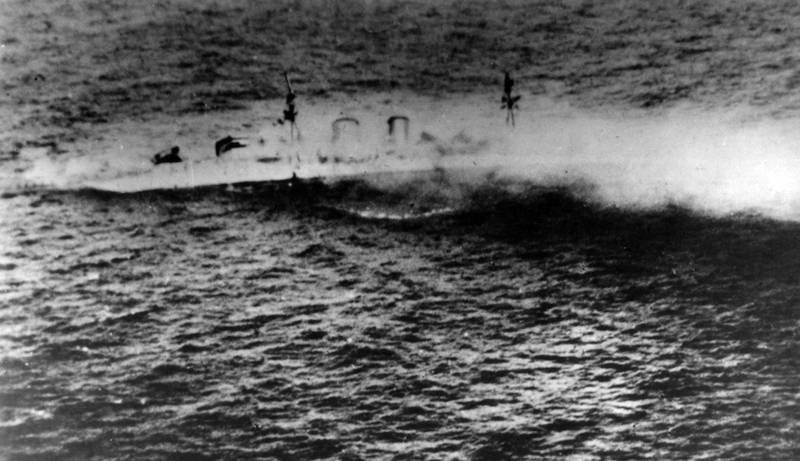
However, after these 7-10 minutes, instead of finishing the Exeter, and then concentrating the fire on one of the light cruisers, irritating the other with the 150-mm guns, Langsdorf seemed to forget that he was leading a “pocket” battleship against three cruisers, and fought as the light cruiser should have fought against three “pocket” battleships. Usually, analyzing this or that naval battle they say about some mistakes of commanders made at one time or another, but the whole battle of Langsdorf, starting with 06.25, was one big mistake. Had a decisive commander in his place - and today the British would remember La Plata in the same way as Coronel, where Maximilian von Spee, in whose honor Langsdorf’s ship was named, was remembered, destroyed the squadron of British Admiral Cradock.
This did not happen, but not because the designers of the Admiral Count Spee did something wrong. It is impossible to blame the ship’s design for the indecision of its commander.
Recall how to create "pocket" battleships. The Versailles Treaty limited the displacement of the six largest ships in Germany, which she was allowed to build 10 thousands of tons, but did not limit the caliber of their guns. As a result, the German Navy, like the epic warrior, was at a fork in the three roads.
On the one hand, it was proposed to build such semi-messenger-semi-monitors - four 380-mm guns, 200 mm of armor of the citadel and the speed of the 22 node. The fact is that the countries surrounding post-war Germany (Poland, Denmark, Sweden, Soviet Russia, etc.) had moderate force fleets, the most powerful ships of which carried 280-305-mm artillery. The only exception was France, but in Germany it was believed that the French would not risk sending their dreadnoughts to the Baltic, which, after the France explosion, there were only six left, and would be limited to a maximum of Dantons. In this case, six ships with 380-mm cannons practically guaranteed the domination of the Baltic on the Germans and thereby restored to it the status of a naval power.
On the other hand, Germany, at the very beginning of 1923, appeared draft sketches of the I / 10 project. It was almost a classic “Washington” cruiser, in which, by the way, the future Admiral Hipper’s features were well guessed - 10 000 t, 32 knot, 80 mm armor belt with 30 mm deck and bevels and four two-tower turrets with 210-mm guns
However, both of these versions of the German sailors did not satisfy (although the future Commander Grigsmarine Raeder was inclined to the version of the 380-mm ship). The fact is that the German Navy did not want to limit itself to coastal defense, hoping for more, and therefore little seagoing armadillos-monitors were unacceptable for him. As for the cruisers, they were very interesting to the sailors, but having built them, the Germans would have received six quite ordinary ships, which the leading naval powers had considerably more, and which could not cause England’s concern. The six "almost Washingtonians", of course, did not pose a big threat to British shipping.
And finally, there was a third route proposed by Admiral Zenker, who in the recent past commanded the Fon der Tann battle cruiser in the Jutland battle. He proposed reducing the caliber of the future ship by adopting something intermediate between the 150-mm and 380 mm and creating something that would become obviously stronger than any heavy cruiser, but faster than the main mass of battleships of the world that had a 21-23 speed node. So, in 1926 r was born the project 1 / M / 26, which became the prototype of pocket battleships.
What can be said about these ships?
In order to ensure the overwhelming superiority over the heavy cruisers of the world, it was possible to go in two ways - to strongly protect the ship, providing it with moderate-caliber artillery, or to rely on powerful weapons with moderate protection. The first path was traditional for German design ideas, but this time the emphasis was placed on very powerful 283-mm guns, while booking was only slightly superior to that of most armored cruisers, even, perhaps, behind the most protected ships of this class. Yet the armor applied on the “pocket” battleships could not be called bad. Even on the weakest head “Deutschland”, as V.L. Kofman, she from any angle provided from 90 to 125 mm the total thickness of armor with a combination of horizontal and vertical (mostly inclined) obstacles. At the same time, the booking system was improved from ship to ship, and the most protected of them was the Admiral Count Spee.
Heavy-duty artillery was supplemented with an excellent fire control system - the “pocket” battleships were provided with three command-range posts (KDP) each, one of which had an 6-meter rangefinder, and the other two were 10-dimensional ones. KDP were protected by 50 mm armor, and the observation of them could be carried out through periscopes. Let's compare this splendor with the British Kent cruisers, which had one 3,66-meter rangefinder in the conning tower and two of them that stood open on the wings of the bridge, as well as the 2,44-meter rangefinder on the aft wheelhouse. Data from rangefinders on British ships processed the central post, but there were two of them on the German “pickpockets” - under the bow and stern logging. Not all battleships could boast such a perfect MSA. German ships were equipped with artillery radars, but their quality was very low and did not allow to adjust the fire, so that they were used only to detect potential targets.
Contrary to popular belief, initially 150-mm artillery of pocket battleships was not at all a “poor stepdaughter” in fire control — it was assumed that the distance to its targets would be measured by one of the control gearboxes, and a backup center located in the stern of the ship would be generated . But in practice, the commanders preferred to use all three KDPs to ensure the work of the main caliber, and the stern settlement center was given the responsibility to “supervise” the anti-aircraft artillery - so it turned out that there was no one to deal with the 150-mm auxiliary caliber.
Thus, the Germans turned out to be a ship capable of quickly destroying an enemy cruiser with the help of powerful artillery and SLA, and protected so as not to suffer heavy damage during such a battle. Given the fact that his diesel power plant provided him with a range of up to 20 000 miles, the “pocket” battleship became almost the ideal heavy artillery raider.
Of course, he had his shortcomings. In an effort to meet the weight requirements, the company MAN overburdened diesels, as a result of which they were exposed to strong vibration and made a lot of noise. Critics of the project quite rightly pointed out that it would be better for the “pocket” battleship to take less ballast, but to make the diesels heavier (whatever one may say, they are located at the very bottom of the hull) and the project would only benefit. However, it should be noted that the commonly mentioned inability to communicate, notes and blood from the ears still apply to cases where the ship was in full swing, otherwise the noise was not so strong. Intermediate caliber - 150-mm artillery, was also a mistake, it would be better to strengthen anti-aircraft weapons or armor. The reservations were considered by the Germans to be sufficient for a medium-range battle, but the hit of an Essex 203-mm projectile, in which both the armor belt and the 40-mm bulkhead were punched behind him, hint that everything was not so clear. If the projectile had passed a little lower, it could have exploded right in the engine room. Were there "pocket" battleships and other, not so obvious flaws, but, strictly speaking, which ship does not have them?
Often the blame "pocket battleship" put a low speed. And indeed - their 27-28 knots gave them an advantage over the battleships of the era of the First World War, but already at the time of laying the leading Deutschland there were seven ships in the world that could catch up with him and destroy them without any problems. We are talking about the Hude, Ripalsa, Rinaun and four Japanese Congo-class battlecruisers. In the future, as the construction of the battleships of the new generation (starting with the "Dunkirk"), the number of such ships grew rapidly.
Is it possible on this basis to consider the German "pocket" battleships unsuccessful ships? Yes, in any case.
First, we must not forget that high-speed battleships have a lot of other things to do except to chase someone across the expanses of the Atlantic and Indian oceans. And here's the result — theoretically, the Allies could send five high-speed battleships and battle cruisers to search for the Admiral of the Count Spee — three British ships and the Dunkirk with the Strasbourg. But in practice, the British managed to attract only Rinaun sent to the South Atlantic to catch the raider, and the French battleships, although formally they were part of the "counter-enemy" groups, did not take any active actions. And this is in 1939 g, when the allies fought only against Germany, and Italy and Japan with their powerful fleets had not yet entered the war!
Secondly, diesel “pickpockets” had a huge advantage over ships with a conventional power plant - they had a very high economic speed. The same "Spee" could pass on 18 nodes more than 16 000 miles, no battleship or battlecruiser could boast such a thing. In other words, yes, the same “Dunkirk”, when meeting with “Scheer”, of course, is able to catch up and destroy the latter, but it would be quite difficult to arrange such a “meeting” with a rapidly moving “pocket” battleship.
And thirdly, it should be understood that the “pocket” battleships, surprisingly, perfectly fit into the kriegsmarine strategy and could play a crucial role in the Anglo-German struggle at sea.
The fact is that the German plan of military operations against Britain, around which the pre-war fascist fleet was created, provided for the following strategy: it should have raider forces sufficient to force the British to send part of their line squadrons to the ocean and high-speed battleship groups able to intercept these squadrons and destroy. Thus, "biting off a piece" of the British fleet was supposed to equalize with him in strength, and then - to achieve superiority at sea.
The logic seems to be absurd, but let us imagine for a moment that the Bismarck’s raid into the Atlantic was for some reason turned out to be postponed or even ended in success.
In this case, by the end of 1941 — the beginning of 1942 — the Germans in the fleet would have fully prepared for battle “Tirpitz”, “Bismarck”, “Scharnhorst” and “Gneisenau”. But the British from high-speed battleships would have only “King George V”, “Prince of Wells” and the Duke of York, which had just been commissioned (November 1941 g) and had not passed combat training, individually ships of the Bismarck type were stronger than the British battleships.
And the rest of the battleships? Some high-speed ships of the type "Queen Elizabeth" are connected by the Italian fleet in the Mediterranean. Bringing them out of there - bring down the whole Mediterranean strategy of Great Britain, which the British would not forgive any government. The ships of the type “Royal Soverin” and “Rodney” are slow-moving and would not be able to intercept the German linear formation, moreover, even at a meeting, it could always evade battle. There remained only the "two and a half" of the English high-speed battleship, and the battle cruisers. France has already capitulated and cannot count on its linear forces, the United States suffered a crushing defeat at Pearl Harbor and cannot help England.
Had this happened, and every high-speed ship would have been with the British in the account. Moreover, the battleships must be periodically repaired - of the six high-speed ships, some will almost always be repaired. The Germans, on the contrary, it is easy to bring their battleships into a combat-ready state by the pre-appointed date of the raid.
For example, the Germans send their "pocket" battleships to raiding. In this case, the British would be in an extremely difficult situation. Send battlecruisers in the sea, in pursuit of "pickpockets"? And risk the fact that the four Krigsmarine battleships will go to sea and will have to fight with them not in full force? This is fraught with defeat, after which the British communications will be defenseless against the raids of heavy German ships. Do nothing? Then the “pocket” battleships will arrange a real massacre on communications. Cover the convoys with old battleships, whose strength is enough to frighten away Scheer? And who can guarantee that the Germans are not attacking such a convoy "Bismarck" and "Tirpitz", which will playfully deal with a single British ship? Will the Grand Fleet's fast-moving battleships have time to intercept the German formation before they tear to shreds and the convoy and its escort ships?
It is known that Churchill assumed and was extremely afraid of the joint actions of the German battleships and attached great importance to the destruction of the Bismarck before the Tirpitz was commissioned.
Thus, we can state that, despite certain shortcomings, the German pocket battleships were quite successful ships capable of performing the tasks that the Krigsmarine had set before them. But why, then, did the Germans stop building them? The answer is very simple - according to the pre-war plans of the German industry, several squadrons of the most powerful battleships were to be built, which, of course, would need cruisers for protection. But the “pocket” battleship did not fit the role of a cruiser in a squadron at all - that's where his low speed was completely out of place. That is why the Germans returned to the idea of a heavy cruiser, which appeared in their distant 1923 year, but this is completely different story...
And - a little note.
Of course, on the basis of their tactical and technical characteristics, “pocket” battleships cannot be assigned to the class of battleships. Where did the name “pocket” battleship come from? The fact is that, in accordance with the Washington 1922 Maritime Agreement, any ship that has a standard displacement above 10 000 tonnes or guns larger than 203 mm was considered a linkor. It's funny, but if the Germans would have preferred the 32 hub cruiser with 210-mm artillery to the “pickpockets”, from the point of view of international treaties, he would be just a linkor. Accordingly, according to the Washington agreement, Deutschland was also a linkor - well, a certain correspondent with a good sense of humor, given the small size of the German ship, added the epithet “pocket” to the “battleship” and this name stuck.
The Germans themselves never considered or called “Deutschland” and its sisterships battleships. In the German fleet, these ships were listed as "panzerschiffe", i.e. “Armored ship”, or “battleship”, unlike “Gneisenau” or “Bismarck”, which were called “schlachtschiffe”. In the Kaiser fleet, “panzerschiffe” was called armadillos, but the most modern of them were renamed “linienschiffe” - battleships, and the dreadnoughts were called “big battleships” or “großlinienschiffe”. Well, shortly before the war, kriegsmarine enrolled "pocket" battleships in the class of heavy cruisers.
List of used literature:
1. Donets A. Heavy York type cruisers.
2. Kofman V. "Pocket" battleships of the Fuhrer. Corsairs of the Third Reich.
3. Patyanin S. "Insolent" cruisers - raider hunters.
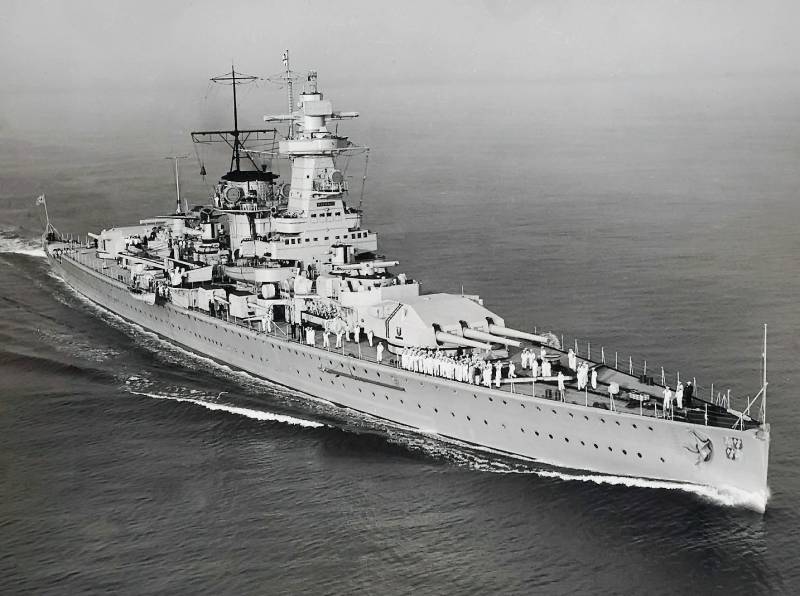
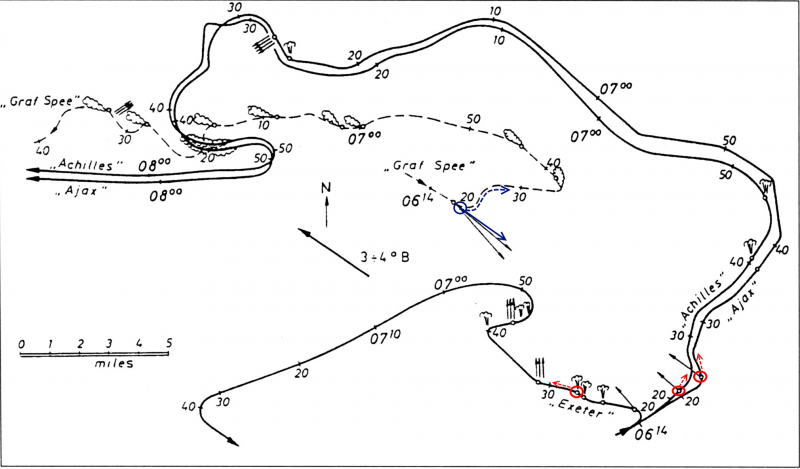
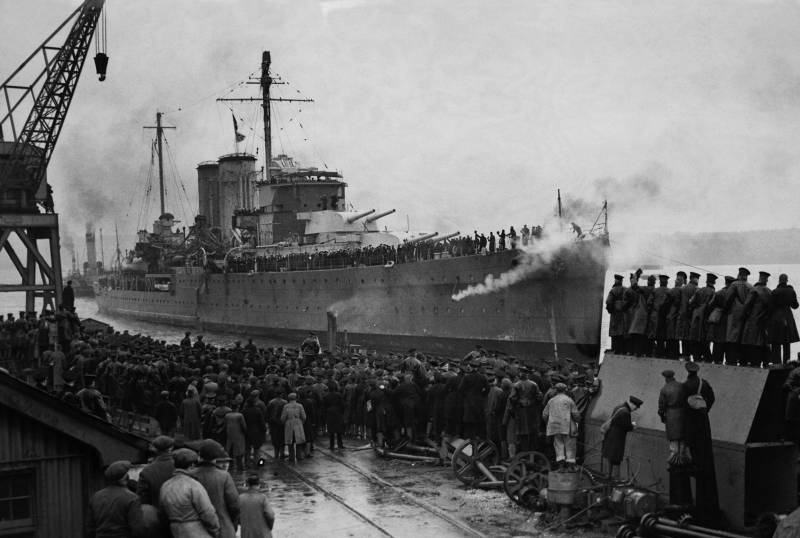
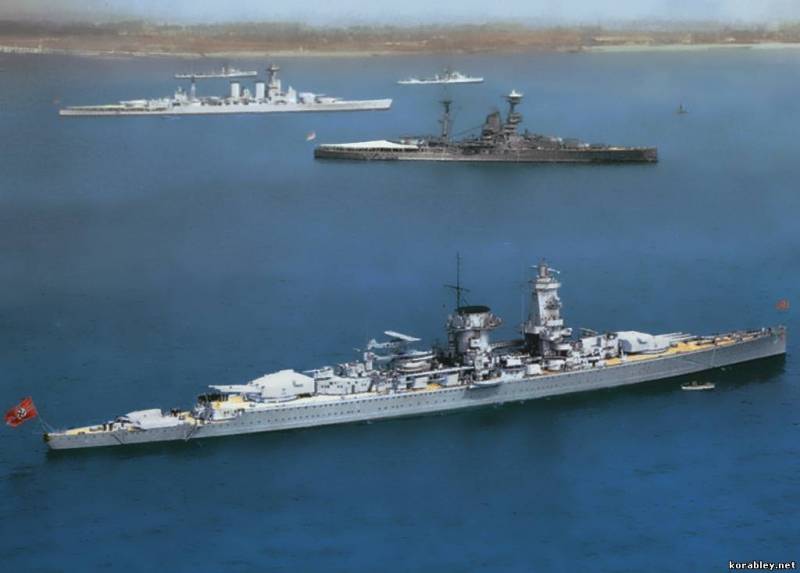
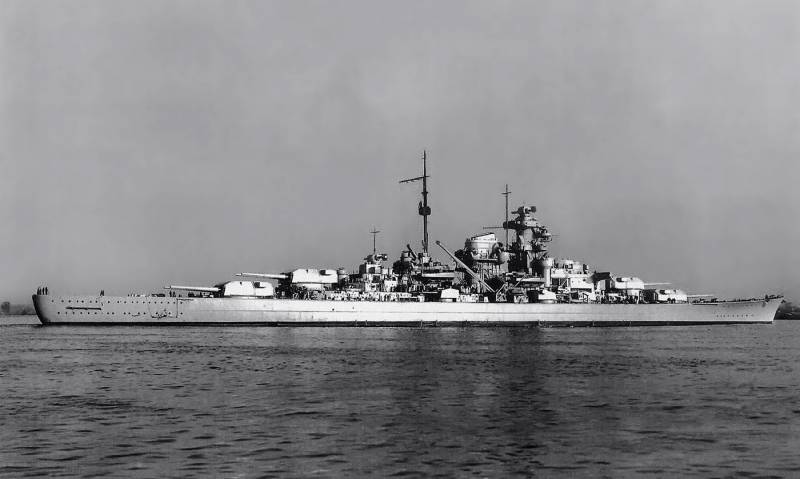
Information